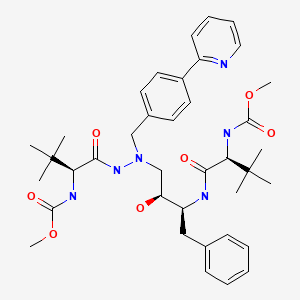Attribution Statement: LactMed is a registered trademark of the U.S. Department of Health and Human Services.
NCBI Bookshelf. A service of the National Library of Medicine, National Institutes of Health.
Drugs and Lactation Database (LactMed®) [Internet]. Bethesda (MD): National Institute of Child Health and Human Development; 2006-.
CASRN: 198904-31-3

Drug Levels and Effects
Summary of Use during Lactation
Amounts of atazanavir in milk appear to be low based on limited data. The combination product, which also contains the CYP3A inhibitor cobicistat, has not been studied during breastfeeding, but would be expected to have similar or greater levels of atazanavir in milk. Achieving and maintaining viral suppression with antiretroviral therapy decreases breastfeeding transmission risk to less than 1%, but not zero. Individuals with HIV who are on antiretroviral therapy with a sustained undetectable viral load and who choose to breastfeed should be supported in this decision. If a viral load is not suppressed, banked pasteurized donor milk or formula is recommended.[1,2]
Drug Levels
Maternal Levels. Three women taking atazanavir (dose not stated, but presumably 300 mg daily) as part of their highly active antiretroviral regimen had sampling of breastmilk and plasma on postpartum days 5 and 14 at 0, 2, 5, 8 and 24 hours after a dose. Median breastmilk levels over 24 hours were 212 mcg/L on day 5 and 265 mcg/L on day 14. Median peak breastmilk levels of 419 mcg/L occurred at 5 hours after the dose.[3]
Infant Levels. Relevant published information was not found as of the revision date.
Effects in Breastfed Infants
Relevant published information was not found as of the revision date.
Effects on Lactation and Breastmilk
Gynecomastia has been reported among men receiving highly active antiretroviral therapy. Gynecomastia is unilateral initially, but progresses to bilateral in about half of cases. No alterations in serum prolactin were noted and spontaneous resolution usually occurred within one year, even with continuation of the regimen.[4-6] Some case reports and in vitro studies have suggested that protease inhibitors might cause hyperprolactinemia and galactorrhea in some male patients,[7,8] although this has been disputed.[9] The relevance of these findings to nursing mothers is not known. The prolactin level in a mother with established lactation may not affect her ability to breastfeed.
References
- 1.
- World Health Organization. Consolidated guidelines on HIV prevention, testing, treatment, service delivery and monitoring: Recommendations for a public health approach. 2021. https://www
.who.int/publications /i/item/9789240031593 [PubMed: 34370423] - 2.
- Department of Health and Human Services. Recommendations for the use of antiretroviral drugs during pregnancy and interventions to reduce perinatal HIV transmission in the United States. 2024. https:
//clinicalinfo .hiv.gov/sites/default /files/guidelines/documents /perinatal-hiv /guidelines-perinatal.pdf - 3.
- Spencer L, Neely M, Mordwinkin N, et al. Intensive pharmacokinetics of zidovudine, lamivudine and atazanavir and HIV-1 viral load in breast milk and plasma of HIV + women receiving HAART. 16th Conference on Retroviruses and Opportunistic Infections Montreal, Canada 2009:942.
- 4.
- García-Benayas T, Blanco F, Martin-Carbonero L, et al. Gynecomastia in HIV-infected patients receiving antiretroviral therapy. AIDS Res Hum Retroviruses 2003;19:739-41. [PubMed: 14585204]
- 5.
- Pantanowitz L, Evans D, Gross PD, et al. HIV-related gynecomastia. Breast J 2003;9:131-2. [PubMed: 12603389]
- 6.
- Evans DL, Pantanowitz L, Dezube BJ, et al. Breast enlargement in 13 men who were seropositive for human immunodeficiency virus. Clin Infect Dis 2002;35:1113-9. [PubMed: 12384846]
- 7.
- Hutchinson J, Murphy M, Harries R, et al. Galactorrhoea and hyperprolactinaemia associated with protease-inhibitors. Lancet 2000;356:1003-4. [PubMed: 11041407]
- 8.
- Orlando G, Brunetti L, Vacca M. Ritonavir and saquinavir directly stimulate anterior pituitary prolactin secretion, in vitro. Int J Immunopathol Pharmacol 2002;15:65-8. [PubMed: 12593790]
- 9.
- Montero A, Bottasso OA, Luraghi MR, et al. Galactorrhoea, hyperprolactinaemia, and protease inhibitors. Lancet 2001;357:473-5. [PubMed: 11273087]
Substance Identification
Substance Name
Atazanavir
CAS Registry Number
198904-31-3
Drug Class
Breast Feeding
Lactation
Milk, Human
Anti-Infective Agents
Antiviral Agents
Anti-HIV Agents
Anti-Retroviral Agents
HIV Protease Inhibitors
Disclaimer: Information presented in this database is not meant as a substitute for professional judgment. You should consult your healthcare provider for breastfeeding advice related to your particular situation. The U.S. government does not warrant or assume any liability or responsibility for the accuracy or completeness of the information on this Site.